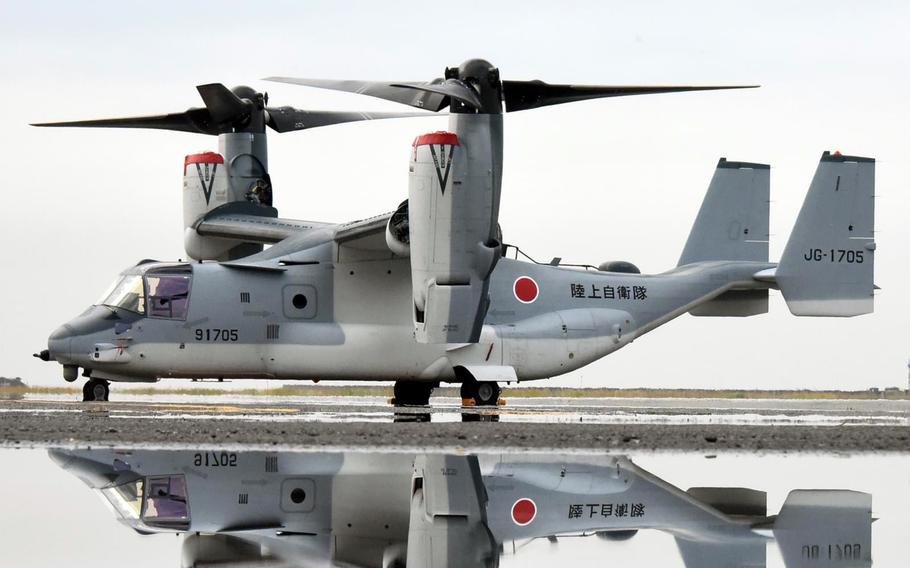Asia-Pacific
‘Pilot error’ behind Japanese Osprey damage; tiltrotors resume flights
Stars and Stripes November 14, 2024

Japan resumed Ospreys flights on Nov. 14, 2024, after an investigation determined that pilot error caused one of its tiltrotors to hit the ground and sustain damage during a joint U.S.-Japan exercise last month. (Japan Ground Self-Defense Force)
Japan’s Osprey fleet resumed flying Thursday after investigators ruled that pilot error resulted in damage to one of the tiltrotor aircraft during a joint exercise with U.S. forces last month.
The Ground Self Defense-Force V-22 was attempting to take off Oct. 27 from Camp Yonaguni, a Japanese base on a remote island west of Okinawa, when its left wing hit the ground during a disaster-response drill, according to a Japan Joint Staff news release that day.
None of the 16 troops on board were injured, and only the aircraft was damaged. Three U.S. Marines were aboard at the time, according to an unsigned email from U.S. Forces Japan on Oct. 31.
The Ground Self-Defense Force investigation committee determined the pilot forgot to turn on the “interim power switch,” which provides additional engine power for takeoffs, a Ground Staff spokesman said by email Thursday.
Flight procedures require that the switch be turned on after the engine is started and during takeoff, he said.
The pilot also did not “maneuver the aircraft properly when it was close to the ground,” which caused it to shake from left to right, the spokesman wrote.
Additionally, the number of personnel boarding the aircraft increased just before takeoff and their arrival was delayed, which “caused an increase of items for the pilot to handle,” the spokesman said.
“As a result, this caused the pilot to forget to turn on the switch,” he said.
To prevent future incidences of loss of altitude during takeoff, Japan’s ground forces will add markings around the interim power switch and provide education and training to pilots and copilots on “operating instructions prior to transferring to hovering,” the spokesman wrote.
The army also will provide “training and experience using simulators under multiple situations,” he said.
To prevent future incidences of shaking or instability, pilots and copilots will be trained in emergency operations while losing power during takeoff, including “lectures, simulator flights and actual aircraft flights” the spokesman said.
Japan’s ground forces also will “create a concrete plan including emergency responses” and provide “education from the commander starting from the plan creation stage,” he wrote.
Some Japanese government officials are required to speak to the media only on condition of anonymity.
The Osprey pilots have been training with simulators and attending lectures since Monday, the spokesman said. Japan’s fleet of 17 tiltrotors were grounded after the incident.
The damaged Osprey is still at Yonaguni, and the spokesman did not provide a date for when it will be recovered or repaired.
U.S. Marines sent a team to Yonaguni earlier this month to assist Japan in “identifying or validating safe and feasible recovery solutions” for the Osprey, 1st Marine Aircraft Wing spokesman Maj. Joseph Butterfield said by email Thursday.
“This is the extent of the Marine Corps’ involvement,” he wrote. “However, we remain prepared to assist our [Japan Ground Self-Defense Force] counterparts if requested.”
U.S. and Japanese Ospreys were grounded between December and March following the Nov. 29 crash of an Air Force Special Operations Command tiltrotor just off Yakushima, an island south of Kyushu in southern Japan.
All eight crew members aboard that Osprey were killed. The accident investigation found a catastrophic mechanical failure at fault, compounded by a “lack of urgency” by the crew to deal with an engine problem, according to the accident report.
The revolutionary aircraft lands and takes off like a helicopter but flies as a fixed-wing aircraft.